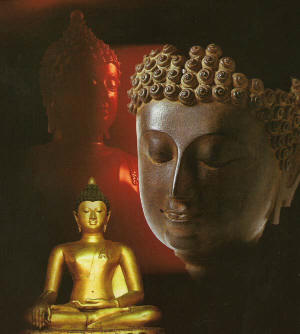Ayutthaya Art
Thai Ayutthaya Style Art

- Thai Ayutthaya art refers to the art and style of the Ayutthaya Kingdomwhich existed from 1350 until 1767. The early period reflects Dvaravati and Lop Buri influences but from the middle of the 15th century it developed to its nationally renowned style, which was inspired by the earlier Sukhothai and U Thong features. Artworks were created in bronze, woodcarving, stucco and sandstone.
- Many works of art were destroyed during the Burmese invasions.
- The art of the period is classified into four periods, first [ 1350 to 15th centuries ] when U Thong influences were predominant, second, from mid 15th century until 17th century during which influences of Sukhothai were dominant, third, in the17th C when the Khmer became vassals of the Ayutthaya Empire and their art was again fashionable, and finally from late 17th century until 1767 when splendor was fashionable and the images of Buddha were ornate with crowns and ornate robes.

AYUTTHAYA ART : Art beyond borders
An exhibition at the National Museum showcases works crafted by Siamese artisans for Portuguese emissaries 500 years ago  When the Portuguese came ashore in Ayutthaya 500 years ago, they brought with them not just weaponry, churches and convents, but also art. When the Portuguese came ashore in Ayutthaya 500 years ago, they brought with them not just weaponry, churches and convents, but also art.There an aesthetic interaction took place. Siamese craftsmen helped further develop their art, and finally created something new - an Ayutthaya-Portuguese genre that inspired successive generations of Portuguese chroniclers, explorers and missionaries. These precious art objects were taken with them back to Lisbon where they still adorn museums and private collections. Some of these have just returned to their birthplace five centuries on for the exhibition "Thailand and Portugal 500 Years of a Common Past: The Art Legacy" at the National Museum in Bangkok. Among the limited exhibits are ivory figurines of a reclining Buddha and the young Jesus Christ on loan from the private collection of Alvaro Sequeira Pinto, owner of one of the greatest collections of Portuguese Asian art. He also owns a wood chest, on display in this show too. The only bookcase comes from the National Library in Bangkok. Created by Siamese artisans, these objects offer a glimpse into the history of Siamese-Portuguese relations. Myth had it that Siam was ruled by a Christian king and was a distance of 55 days travel from Calicut. It was the Portuguese who helped correct this European image of Siam. Portugal's Afonso de Albuquerque sent Duarte Fernandes as an ambassador to meet King Rama Thibodi II in 1511. He came bearing a letter proposing commercial agreements, together with a few valuable gifts. The king hosted the Portuguese emissary very fittingly and rejoiced at the attack on Malacca when it came under the rule of the Portuguese. Fully aware of Portugal's presence in India, the King of Ayutthaya expressed interest in seeking Portuguese help in many ways. He wanted Portuguese merchants to expand Siam's commerce into India and strengthen Siam's army in the wake of Burmese invasions. As a result, Portuguese soldiers became a common sight in Ayutthaya. The Portuguese figure prominently in temples' murals, lacquer decorations and art objects, underlining their importance to Siam's sovereignty. A wood chest from the Tavora Sequeira Pinto collection is believed to have originated in Ayutthaya. On its surface is magnificent gilded lacquer work featuring a place with various buildings alternating with ample gardens containing flowerbeds and tanks, fresco houses and gazebos, balustrades delimiting space, large parasols protecting dignitaries and other characters. We are in the presence of a large number of buildings where sacred, residential, recreation, social and defensive spaces are clearly defined. There are military officers, courtiers, dignitaries, religious men and servants. The king is placed under an immense parasol. . Others have modest turbans around their heads. At one end musical instruments are being played. Other men hold cocks preparing for a fight. It's believed that this featured landscape is the Royal Palace of Ayutthaya before its destruction in 1767 and subsequent abandonment. The military officers were Portuguese. Another Portuguese soldier clearly appears in the lacquer front of the book case from the National Library in Bangkok. Some of these soldiers were sufficiently impressed with Siamese craftsmen and artisans in Ayutthaya to commission our artisans to make ivory figurines of Jesus Christ to be placed at their churches in Ayutthaya or back home in Lisbon. On display are a number of small ivory figures of Christ in different poses. The most striking are poses that resemble various gigantic reclining Buddha sculptures found at temples in Ayutthaya. These figurines are thought to have been crafted by Siamese artisans in Ayutthaya. One figure is rendered like a reclining Buddha over a mantle of jasmine leaves. The manner in which Christ lies is very Thai, with his right hand supporting the head and the other resting freely along the length of his body. Another figure features the hand touching the face but the head resting on a more traditional pillow. The hair is long. But the most beautiful is the figure of Christ lying on a lacquered wooden bed, with a canopy supported by spiralled columns and rounded bases topped with pinnacles and urns. The canopy is concave on top and fully decorated with typical Thai gilded motifs. The small bed is one of a kind and clearly from Southeast Asia Another one lies embracing a lamb over the Book of Faith. His hair curls into bundles, the eyes are almond shaped, the navel salient and there is a careful treatment of hands and feet. These artefacts serve as a testament to the artistic exchange that took place five centuries ago between Portugal and Ayutthaya. Given the limited number of surviving art objects on display, there's much to explore in the artistic relations between the two kingdoms. By Manote Tripathi My Ebay Store |


ไม่มีความคิดเห็น:
แสดงความคิดเห็น